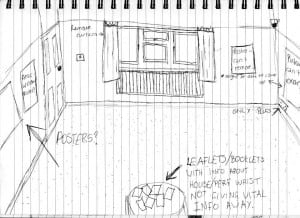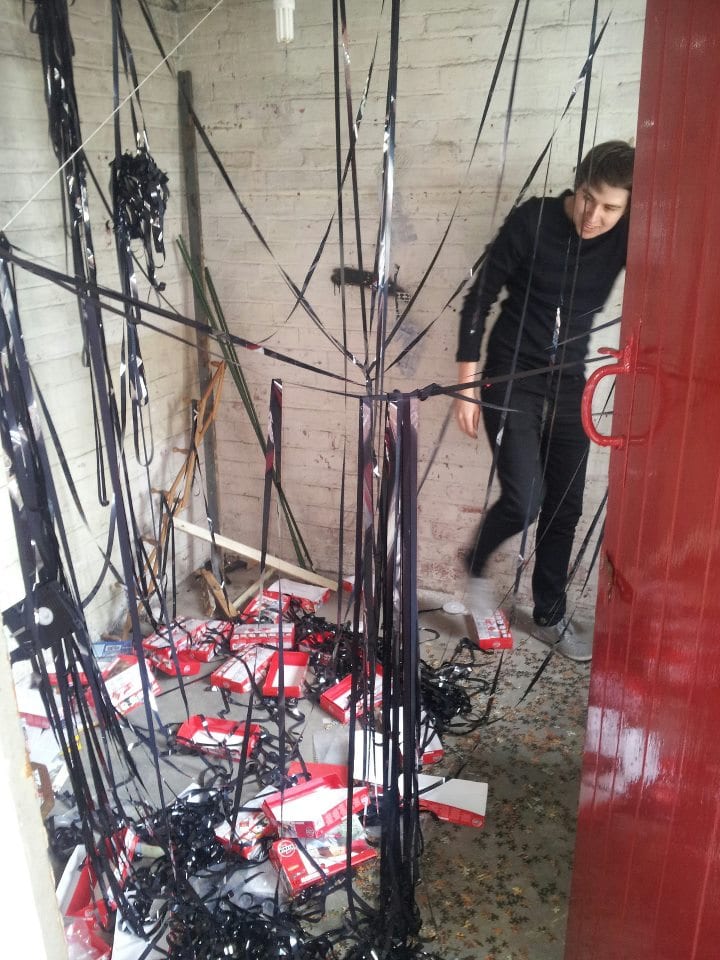With regards to the cupboard the four of us have had many ideas of how to approach it. Is it a space for a performance to take place? Is it a place that should just be viewed by the audience? The answer of how we should approach the cupboard seems to have alluded us so far, but recently we have been discussing the ideas of installation art. The function of the cupboard in its most basic form is to store the possessions of whoever resides in the bedroom. Therefore would it be effective to take that notion of storage and possessions and turn it into an art piece for our performance?
It would seem that “The final decade of the 20th century saw the passage of installation art form a relatively marginal art practice to the establishment in the current central role in contemporary art. ‘These days installation art seems to be everybody’s favourite medium,’ wrote the influential American critic Roberta Smith in 1993.” (2003, P.13) Thus the four of us have decided to experiment with converting the cupboard into an installation piece, using its function for storage in an artist way. If we mix objects from our childhood with objects that we own as adults will the mixture represent the different connotations of the bedroom?
A bedroom, as mentioned earlier, has two clear purposes, the child’s bedroom which seems so innocent, and an adult’s bedroom that is viewed with sexual connotations. “To create a piece of Installation is to make it with a direct correlation to the environment with which it exists. There must be a direct physical relationship to its location.” (Schaefer 1994) which is something we have considered when thinking about using the cupboard as a piece of installation art. By putting objects that are found in a typical bedroom, whether it is a child’s or adults, we are creating a physical relationship between the bedroom and the function of the cupboard in an artistic way. “A form of art that is not defined in terms of any traditional medium but in terms of the message it conveys by whatever means.” (2003, P.14) So we must now consider what message we are trying to send to the audience with our installation art.
As I seem to have mentioned in my previous posts, perhaps the mixing of adult and child like content is to signify the chaos that is associated with growing from a child into an adult. After all the book that we have chosen to read to our audience members, Alice in Wonderland, is often considered to be the story of the how the girl Alice is growing up, and how the author misses the innocent girl that she used to be. (Maata, 1997) Perhaps that is another of the messages that we would like to convey, the loss of innocence as we find ourselves growing up.
As each person grows they don’t notice the changes that occur within themselves. They look in the mirror every day, they think about different subjects’ everyday, and so the progress of time isn’t noted. They are unable to see themselves change because everyday they face all of their smallest changes head on. It isn’t until someone we haven’t seen for a long time, or spoken to for a long time, tells that we have changed do we notice it ourselves. We don’t necessarily realise we’re growing, both in mind and in body, until we specifically think about. So when you are faced with a cupboard filled with items from your childhood, and from your adulthood, will it make you think about how much you have changed? When you look into this cupboard where there is no middle ground between what you were as a child and what you are now. What happened to make you who are you are? What is the difference between who you were as a child and who you are in the present? Perhaps you will wonder when exactly you began to change. Will you wonder when you began to realise the world wasn’t black or white, but grey? Will you ask yourself, when did I grow into this?
Works cited:
De Oliveira Nicolas, Oxley Nicola, Petry Michael (2003) Installation Art in the new millennium London: Thomas & Hudson. Ltd
Maatta,Jerry, (1997) http://www.alice-in-wonderland.net/explain/alice841.html Sweden; March. (last accessed 8/4/2013)
Schaefer, Janek (1994) 6 Elements of Installation http://www.audioh.com/press/6elements.html (last accessed 9/4/2013)



